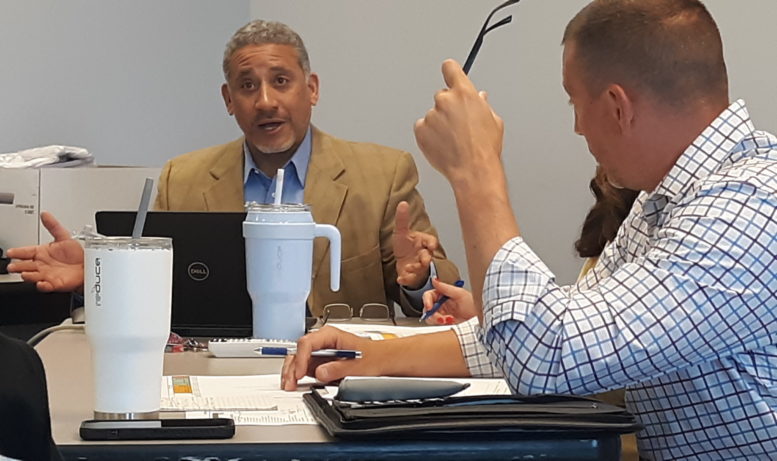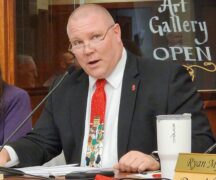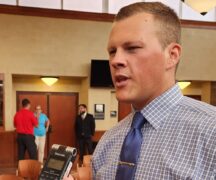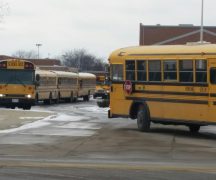By JAN LARSON McLAUGHLIN
BG Independent News
Bowling Green Board of Education voted unanimously Monday to put a split property/income tax on the ballot in November to build a new high school.
“This is a very serious vote we’re about to take,” board President Jill Carr said during the special meeting.
After the vote was in, High School Principal Dan Black voiced his support.
“This is a great step for our community and for our kids,” he said after the meeting. “It’s very exciting for the community.”
The board came into Monday’s meeting with three funding options to pay for the new $70 million school building. First was a traditional property tax. Second was a 50/50 split between property and income tax. And third was the 70/30 split, with property tax paying the larger share. The board went with the 70/30 split.
The issue would require an estimated 3.9 mills in property tax for 30 years and 0.5% income tax increase for seven years
Based on a house value of $100,000 and a median family annual income of $66,215, the property tax portion would cost $136 a year, and the income tax portion would cost $331 a year. Since the income tax would be dropped after seven years, the payments would then be reduced to $136 a year.
The board was in agreement that the split tax was a good compromise.
“I’m very excited about this. I think it’s the right way to go,” Carr said after the meeting. “I’m feeling very optimistic.”
The board was in consensus that the district can’t wait any longer to replace outdated buildings.
“We just have to forge ahead,” Carr said.
The last time the district attempted a bond issue, a citizens finance task force recommended that the issue not rely completely on property taxes.
“That way everyone will feel they have skin in the game,” board Vice President Ryan Myers said.
Myers added that the short duration of the income tax – which runs out after seven years – will allow the district flexibility to address elementary building needs sooner.
“We know the elementaries still need to be addressed,” he said.

Board member Tracy Hovest agreed that the split issue makes the cost “more manageable” for local residents.
“I’m so excited. I just feel like now we can move forward,” Hovest said. “I feel good about it.”
Board member Ginny Stewart said the split asks everyone in the district to contribute.
“I believe the board chose the best option,” Stewart said. “It’s the best way to proceed in order to get this going. We need to do something with our buildings.”
A new high school will bring more families to Bowling Green, she added.
“We need to get something on the ballot that will benefit the community.”
Geer said he favored the 70/30 split since the district has a great deal of real estate wealth. “That’s part of the reason we’re considered an affluent district,” he said.
So while the split is a compromise, it still relies on the strong property values.
“It just makes sense to me,” Geer said.
The tax issue has built in money for annual maintenance on a new building.
The board was apprehensive about putting a tax issue on the ballot since the last three efforts to fund a new elementary school failed – the last one by just 32 votes.
But there is some confidence that a less controversial goal of a new high school rather than a new consolidated elementary, could get voter support.
With property taxes, the addition of new residents and new businesses in the district help bring down the amount collected from the original property owners. The district’s tax base is about 30% businesses.
With income taxes, if the community grows, the revenue will grow. But only residents of the district pay income taxes – not businesses. Income taxes place more burden on the poor in the community.
“If we don’t tax our businesses, and we have to make it up in income (taxes), who are we hurting?” Stewart said. “In doing this are we hurting this community – which is the last thing I want.”
David Conley, financial consultant to the school district, pointed out that incomes in the school district have decreased in the last decade. The number of people with incomes over $75,000 has dropped from 17% to 12%. A third of district residents have incomes between $35,000 and $75,000.
However, the district is sensitive to agricultural property owners, who have said they will support an increase in income taxes but not property taxes. But voting records show that the rural areas of the district didn’t vote in favor of the last proposal that split the cost 50/50 between property and income taxes.
The district has also heard complaints from large rental property owners in Bowling Green, who oppose property taxes to pay for school buildings.
Social Security income is not taxed by either property or income taxes, Conley said.
With interest rates and inflation climbing, the board agreed that waiting will only cost more money.
“There’s no relief in sight,” Conley said.
Conley mentioned that many of the school districts in Ohio that tried levies on May ballots failed.
“A lot of people around the state are feeling the pinch,” he said.
Just since the last meeting in March about financing a new high school, the architectural firm working on the project said the costs have jumped from the original estimate of $58 million. Even with cutting out some “vital areas” and creating smaller classrooms, the project estimate grew to $61 million. The realistic estimate was closer to $66 million.
The board decided that $70 million is a “safe number.”
The depressing realization was that five years ago the district tried to get a levy passed to replace two elementaries and the high school – all for $72 million.
“Look at how much it’s gone up in five years,” board member Ginny Stewart said at the last meeting. “The longer we wait, the more expensive it gets. It doesn’t make any sense to wait.”
Conley said new construction costs have seen increases of 25% to 30%.
“The cost of new school buildings is going through the roof,” he said, adding that the costs are not likely to go back down. “I’ve yet to see a school building get cheaper,” he said.
The board agreed that the November ballot would also be best timing since school issues tend to have higher passage rates when more people show up to vote.
“November is your best month,” Conley said, citing past election results.
If the issue passes, the timeline for the project is tentatively six to eight months for design, then two years for construction, according to Superintendent Francis Scruci.





